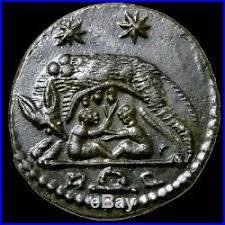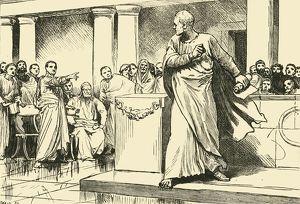The Catilinarian Conspiracy was a notorious episode in Roman history.

Rome’s (probably mythical) founding king, in 753 BC, was Romulus — who with his brother Remus had been suckled by a she-wolf. Eventually the monarchy was overthrown, having become so hated that none of Rome’s later Emperors, for all their grand titles, ever dared call himself “king.”
For half a millennium, Rome was a republic. Power resided in the Senate and a hierarchy of elected officials, topped by two consuls, chosen annually. It’s not clear exactly how those elections were conducted, but apparently the “common” people played a role.

Lucius Sergius Catilina — “Catiline”* — was a politician fiercely ambitious for a consulship. There were actually two “Catilinarian Conspiracies.” The first, in 65 BC, entailed dubious claims of election fraud, and a consequent failed plot to overthrow the consuls. This story is murky and Catiline’s role is doubtful — perhaps a case of “guilt by association” from the second Catilinarian Conspiracy.
That was in 63 BC, when Catiline campaigned hard for a consulship, spending a lot of money (that he didn’t have) and posing as a populist champion of Rome’s “forgotten people.” But he came in third, losing to Marcus Tullius Cicero and Gaius Antonius Hybrida.
Catiline couldn’t stand losing the election, and plotted, with other disgruntled allies, to overturn it and seize power. The plan entailed an army of Catiline’s supporters storming the capital, with Cicero assassinated.

Cicero got wind of the conspiracy and deployed bodyguards to foil the would-be assassins. Then he denounced Catiline in the Senate. Catiline claimed innocence but skedaddled out to the army he’d gathered. A battle ensued; the Catilinarians were defeated, their leader killed. Having earned himself a singularly black name in Rome’s history.
The republic was saved. But not for long, its civic norms having been fatally weakened. Soon came Julius Caesar’s dictatorship, his assassination, and civil wars, with Augustus emerging as the first emperor. Consuls continued to be installed annually, but with no power.

I used to imagine such bloody ancient history had no resonance for modern America. But now we see ominous parallels, with our own Catilinarians — Republicans deluded that they’re righteous “patriots” saving the country from evil others. And they’ve torn down the guardrails that once delineated acceptable, honest, decent civic behavior. January 6 was our first “Catilinarian conspiracy.” The second looms. During Trump’s presidency, I felt hopeful we’d turn the page. Now I’m fearful Republicans will turn it back, determined to do so by any means necessary.
This is not a “conspiracy theory,” but reality. I’ve been trying to sound the alarm; and Barton Gelman writes in The Atlantic detailing how Republican-controlled legislatures in several key states have already put in place the apparatus for overturning the 2024 election. The New York Times daily briefing has also highlighted this threat. Which frankly most Democrats seem asleep about.
The plan is for legislatures to set aside popular votes in those states (on some phony fraud pretext), and appoint Trump electors instead. They’ll be counted if Republicans control Congress. But in any case, and even if they only hold the House of Representatives (looking likely), they can simply block the electoral vote certification. That would throw the election to the House, which will vote Trump in. A perfectly constitutional coup. And the end of American democracy.
On January 6, 2021, Trump’s Catilinarians stormed the Capitol in a failed attempt to stop the electoral vote count. Four years later, they’ll need no resort to violence if they control the House of Representatives.

Will defenders of democracy storm the Capitol to stop them?
* Alternately spelled “Cataline” (as in the newspaper version of this commentary). Further research indicates “Catiline” is preferred.
